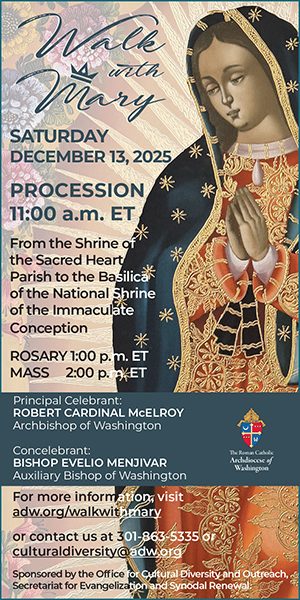At 7 a.m. on May 18, 2025, St. Peter’s Square was crowded. By 8:30, it was totally packed. The square was filled with priests, bishops and lay people alike there to celebrate the inauguration Mass of Pope Leo XIV. We stood there waiting until around 9:15, when Pope Leo emerged from St. Peter’s Basilica and began to greet the crowd.
People were there from all parts of the world. I was standing right next to two Peruvians who seemed pretty proud that the former bishop of Chiclayo was now pope. I saw flags from Africa, from Asia, from the United States, and surprisingly, two separate flags held by groups from the far-off island nation of Samoa. We were all united in faith and in support of the new pontiff. I have often felt, as a person of mixed heritage, that the Catholic Church is the only place where I feel truly at home. We pray that Pope Leo continues Pope Francis’ message of inclusion, so that all can find refuge in the universal Church.
I was reminded there, looking up at the loggia, of a scene from one of my favorite books, “A Canticle for Leibowitz.” It tells the story of a world in the aftermath of nuclear war, where the surviving humans reject science and knowledge as the cause of war. They fiercely persecute the church, which was determined to preserve the intellectual heritage of humankind. At some point after the war, a New Rome was established somewhere in North America, and the main character, Brother Francis, goes on a pilgrimage there to see the pope canonize his order’s patron saint. Brother Francis notices the worn nature of the new St. Peter’s. The plaster on the walls is faded, the carpets are worn, and even the pope’s cassock has a hole.
While the original Rome is still standing, and is in much better shape than the New Rome in that novel, I was still struck by the antiquity of the building that formed the backdrop for the papal Mass. It represents an enduring Church, one which survived imperial repression, barbarian invasions, countless wars, and the political machinations of centuries of kings, princes and emperors. The Roman Empire is long gone, but the successor of Peter was about to step out in front of us.
The pope in that story, also named Leo, reminded me very much of our new pontiff. Initially just a faraway white dot near the altar, Pope Leo stepped inside his popemobile and went into the crowds. When he passed by me, I could see his smile, the warmth in his eyes. But it also seemed that he could feel the weight of this new office which the cardinals bestowed upon him. This only intensified when Filipino Cardinal Luis Antonio Tagle placed the fisherman’s ring on Pope Leo’s finger, a symbol of the pope’s authority. Pope Leo’s face on the screens said it all. Pope Leo humanized the office of the papacy that day. Not just for us Americans, who now have a pope who speaks our language and shares our culture, but for everyone. The emotion he was feeling during his inauguration Mass was palpable.
While the readings were in English, Spanish, and Italian, the set parts of the Mass were all in Latin, except for a Gospel reading in ancient Greek. Although we were from all corners of the Earth, we were all able to pray together in a common language, the language of our saints and scholars, that of the universal Church. In a time where unity is more needed than ever, it was a profound sign to pray in Latin during the inauguration of a pope who can, we hope, be a unifying figure within the Church, and also one who calls out to the world for peace and unity, and brings groups in conflict together. Pope Leo has already stated his intention to continue the Vatican’s work of conflict mediation. May we all be successful in promoting unity in our own lives, countries and societies.
(Gavin Ros, a 2024 graduate of the Heights School in Potomac, Maryland, and a parishioner of Mother Seton Parish in Germantown, is a student at Loyola University in Chicago.)







